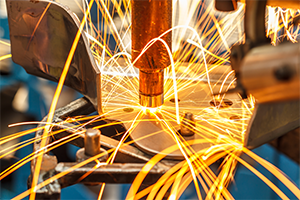Data is the fuel of your AI engine. Luckily, the value of data never decreases and gets more useful the more you use it. But how to extract it and use it effectively? What to ingest directly and what to store for future use? How are digital twins allowing AI to understand production and manufacturing operations?
Transforming raw data (“Red, 192.234.235.245, v2.0”) into information that has meaning (“South facing traffic light on corner of Pitt and George streets has turned red”), then into knowledge with context (“The traffic light I am driving towards has turned red”) and lastly into wisdom that can be applied (“I better stop the car”) presupposes access to a large amount of data, the building blocks of AI within Industry 4.0.
While the generic IoT (‘Internet of Things’) domain focuses on connecting customer-level devices to offer better services to customers, IIoT (‘Industrial Internet of Things’, also known as ‘Industrial Internet’) connects critical machines in the industry, where failure can often result in emergency situations. It’s a domain on which rests a large part of future innovation and continuous improvement “that will transform many industries, including manufacturing, oil and gas, agriculture, mining, transportation and healthcare”, according to the World Economic Forum. To put the importance of IIoT into context, it will account for nearly two-thirds of the world economy. Networking machinery, sensors and control systems together allows to measure, control, automate, optimize in real time and manage assets, improving productivity and nurturing new business models: Accenture estimates that IIoT may generate $12 trillion of global GDP by 2030.
Sensors, sensors everywhere
To optimize a manufacturing plant, intricate details must be obtained about the site production lines and hence about the machines and their components. This is done by collecting information either by connecting directly to these components if they have an interface, or by placing sensors measuring temperature, speed, pressure, or other units of interest.
In recent years, dropping costs of sensor technology, battery life, the increase in computing power and the lowered cost of data storage raised the limit of how much and what kind of data can be collected from machines. The data can be stored in servers on premise, in the cloud, or can stay on edge devices - machines that are sporadically connected. Innovative data management approaches such as the definition of a solid master data quality can help to guarantee the quality and the standardization (e.g.: timezone format, unit for speed, …) of what is recorded. It can also help to ensure that legacy systems will work in the future, even when a skilled workforce is hard to retain over time and the previous generations’ experts retire. In short, the better the form data takes, the better future improvements will move forward.
Making AI a reality through digital twins
For the AI to consider the granularity and complexity of a factory, to track the raw materials as they’re transformed and to fully understand the interrelations of machines along the production paths, the most efficient track is to build a virtual representation of the different elements of the line and their physical state according to sensors, in the form of a digital twin. This enables the AI to monitor the machines and the processes in context, whatever their state.
Digital Twins & AI: a winning combination to innovate without risks
With a view of the architecture of the lines of the plant and the events happening live, the AI gets the additional benefit of being able to simulate and forecast the impact of upcoming improvements, without the risks of trying it first on real production processes: an AI-empowered engineer can test scenarios, such as what would be the ROI of a change made two years ago or what would be the downstream effects of a different set of parameters. With sensors, IoT endpoints, and a digital representation of reality, the AI can sense and build its understanding through analytics, and act either by recommending actions to humans or through automation if operators and engineers choose it.
IIoT doesn’t imply you must connect everything
Luckily, plant managers, engineers and operators don’t need a fully digitized factory to start harvesting the benefits of IoT, digital twins and AI. They can begin to gather impressive, fast and high ROI results to their business challenges with the digitalization of critical production paths and specific components of a constrained number of machines: if 200 variables are required to solve a business issue, there’s no need to throw away money and time to connect, define and classify 25000 other sensors that can’t generate real, actionable insights. Moreover, the volume and updates of the IIoT data brings forward scalability and cost challenges, while the variety of protocols and standards hampers the possibility of connecting everything: this is why key information that generate the best insights should be extracted as a priority.
What’s more, data is not static, and there are a lot of methods that can transform it into useful information. With a deep understanding of data through extensive business knowledge, it can be polished into key information to build better models. All in all, the large volume of data collected from increasingly connected devices are key to generate valuable insights through AI. We’ve only scratched the surface of what is possible: if there’s data, there’s a way forward.


